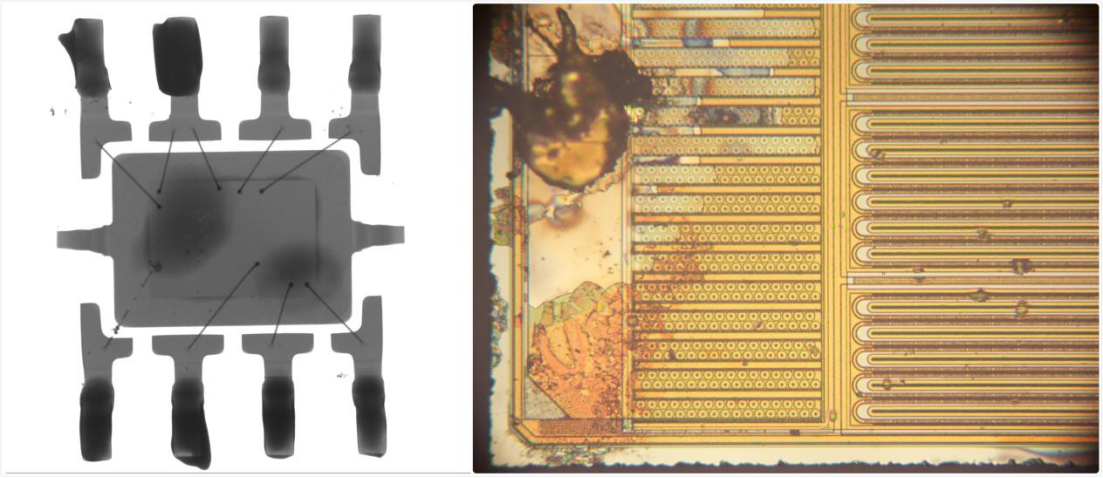SERVICE

-
IC Counterfeit Detection
- IC Counterfeit Detection-Introduce
-
Non-Destructive Testing (NDT)
-
Destructive Testing
-
Value-Added Services
-
Destructive Physical Analysis (DPA)
- Destructive Physical Analysis (DPA)-Introduce
- External Visual Inspection
- X-Ray inspection
- Functional Testing (FT)
- Particle Impact Noise Detection (PIND/PIN-D)
- Hermeticity
- Internal Water Vapor
- Scanning Acoustic Tomography (SAT Testing)
- Solderability Test
- Decapsulation/Delid Test
- Bond Strength
- Die Shear Strength
- Configuration
-
Failure analysis
- Failure analysis-Introduce
-
Non-Destructive Analysis
-
Electrical Testing
-
Fault Location
-
Destructive Physical Analysis (DPA)
-
Physical Analysis
-
Engineering Sample (ES) Packaging Service
-
Competitor Analysis
-
Development and Functional Verification
- Development and Functional Verification-Introduce
-
New Product Development Testing (FT)
-
Key Functional Testing
-
Materials Analysis
- Materials Analysis-Introduce
-
FIB Circuit Edit
-
Structural Observation
-
Compositional Analysis
- EDS Analysis
-
Reliability Testing
- Reliability Testing-Introduce
-
Reliability Verification of Automotive Integrated Circuits (ICs)
-
Environmental Testing
-
Mechanical Testing
- Pull Test
- Die Strength Test
- High Strain Rate Test - Vibration Test
- Low Strain Rate Test - Bending Test
- High Strain Rate Test - Mechanical Shock Test
- Package Assembly Integrity Test - Wire Bonding Integrity
- Package Assembly Integrity Test
- Combined Vibration/Temperature/Humidity Test
- Combined Temperature/Humidity/Vibration/Altitude Test
- Free Fall Drop Test
- Box Compressive Strength Test
-
Corrosion Testing
-
IP Waterproof/Dust Resistant Test
-
Electromagnetic Compatibility (EMC)
- Electromagnetic Compatibility (EMC)-Introduce
- Immunity to Conducted Disturbances, Induced by Radio Frequency (RF) Fields
- Conducted Immunity Test
- Specific Absorption Rate (SAR) Testing for Electromagnetic Radiation
- Electrical Fast Transient/Burst (EFT/B) Test
- Voltage Flicker/Fluctuation Test
- Voltage Dips, Short Interruptions and Voltage Variations Immunity Test
- Power Frequency Magnetic Field (PFMF) Immunity Test
- Harmonic Interference Test
- Electrostatic Discharge (ESD) Immunity Test
- Surge/Lightning Immunity Test
- Radiated Emissions (RE) Test
- Radio Frequency (RF) Test
-
Chemical Analysis
- Chemical Analysis-Introduce
-
High-Performance Liquid Chromatography (HPLC)
-
Pyrolysis-Gas Chromatography-Mass Spectrometry (PY-GC-MS)
-
Inductively Coupled Plasma Optical Emission Spectroscopy (ICP-OES)
- Flame Retardancy Test
描述:通过专业失效分析设备,借助各种测试分析技术和分析程序确认电子元器件的失效现象,分辨其失效模式和失效机理,确认最终的失效原因,并提出改进设计和制造工艺的建议,防止失效的重复出现。
应用范围:
所有失效器件原因分析。
失效分析案例:

X-ray检查 开盖
X-ray检测:发现键合丝断裂,在die上发现疑似烧融的痕迹;
开盖:发现die上局部呈现明显烧融痕迹。

热点分析 去层分析
热点分析:测试发现样品两极之间存在漏电;
去层分析:通过去层后确认失效机理。
失效分析基本概念
1.进行失效分析往往需要进行电测量并采用先进的物理、冶金及化学的分析手段。
2.失效分析的目的是确定失效模式和失效机理,提出纠正措施,防止这种失效模式和失效机理的重复出现。
3.失效模式是指观察到的失效现象、失效形式,如开路、短路、参数漂移、功能失效等。
4.失效机理是指失效的物理化学过程,如疲劳、腐蚀和过应力等。
失效分析的意义
1.失效分析是确定芯片失效机理的必要手段。
2.失效分析为有效的故障诊断提供了必要的信息。
3.失效分析为设计工程师不断改进或者修复芯片的设计,使之与设计规范更加吻合提供必要的反馈信息。
4.失效分析可以评估不同测试向量的有效性,为生产测试提供必要的补充,为验证测试流程优化提供必要的信息基础。
失效分析主要步骤和内容
芯片开封:
去除IC封胶,同时保持芯片功能的完整无损,保持die,bondpads,bondwires乃至lead-frame不受损伤,为下一步芯片失效分析实验做准备。
SEM扫描电镜/EDX成分分析:
包括材料结构分析/缺陷观察、元素组成常规微区分析、精确测量元器件尺寸等等。探针测试:以微探针快捷方便地获取IC内部电信号。
镭射切割:
以微激光束切断线路或芯片上层特定区域。
EMMI侦测:
EMMI微光显微镜是一种效率极高的失效分错析工具,提供高灵敏度非破坏性的故障定位方式,可侦测和定位非常微弱的发光(可见光及近红外光),由此捕捉各种元件缺陷或异常所产生的漏电流可见光。
OBIRCH应用(镭射光束诱发阻抗值变化测试):
OBIRCH常用于芯片内部高阻抗及低阻抗分析,线路漏电路径分析。利用OBIRCH方法,可以有效地对电路中缺陷定位,如线条中的空洞、通孔下的空洞。通孔底部高阻区等,也能有效的检测短路或漏电,是发光显微技术的有力补充。
LG液晶热点侦测:
利用液晶感测到IC漏电处分子排列重组,在显微镜下呈现出不同于其它区域的斑状影像,找寻在实际分析中困扰设计人员的漏电区域(超过10mA之故障点)。
定点/非定点芯片研磨:
移除植于液晶驱动芯片Pad上的金凸块,保持Pad完好无损,以利后续分析或rebonding。
X-Ray无损侦测:
检测IC封装中的各种缺陷如层剥离、爆裂、空洞以及打线的完整性,PCB制程中可能存在的缺陷如对齐不良或桥接,开路、短路或不正常连接的缺陷,封装中的锡球完整性。
SAM(SAT)超声波探伤:
可对IC封装内部结构进行非破坏性检测,有效检出因水气或热能所造成的各种破坏如:o晶元面脱层,o锡球、晶元或填胶中的裂缝,o封装材料内部的气孔,o各种孔洞如晶元接合面、锡球、填胶等处的孔洞。
失效分析流程图




 Weixin Service
Weixin Service

 DouYin
DouYin
 KuaiShou
KuaiShou











